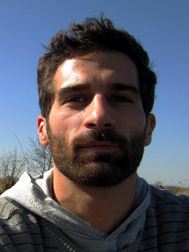Reactive monolayers for surface gradients and biomolecular patterned interfaces
Promotion date: September 19.
Promotor: Prof.dr.ir Jurriaan Huskens
| The results described in this thesis demonstrate the power of reactive monolayers to provide valuable tools for biological applications and to control the local surface composition by the fabrication of surface gradients. In both cases, reactive self-assembled monolayers (SAMs) allow the systematic investigation of micron-scale physicochemical phenomena at interfaces. Reactive monolayers thus constitute a valuable tool for the modification of surfaces leading to new functionalities and novel materials. We expect that future developments will show new functionalization schemes in particular by the integration of dynamic systems in the fabrication processes, thus providing spatiotemporal control over the surface composition and properties and allowing to tackle unique challenges in surface science and biology. |
Was your research fundamental in nature or more application oriented?
The research was focused on the fabrication of micron scale surface chemical gradients and biologically active surface patterns. The research combined the fundamental investigation of the reactivity of chemical reactions at the liquid/solid interface with the fabrication of microchips for biological applications. My projects were strongly experimental in nature, and were carried out in the labs of the Molecular Nanofabrication group, here at Mesa+.
Were there some memorable moments during your PhD period?
At the end of my first year I recall the turning point of my research, with the successful development of a new fluorogenic platform for the simultaneous surface immobilization and visualization of thiols, that I have used and implemented for the fabrication of bioactive microarrays. This new platform has promising biological applications and led to three publications and a follow-up project. It is an efficient way to detect the covalent surface immobilization of small as well as big (e.g. proteins) molecules, with particular control over orientation and selectivity. I was very glad when my first paper was published and awarded with the graphical cover of that issue.
A second memorable achievement was accomplished later on with a fruitful collaboration that led to the fabrication of micron-scale surface chemical gradients for the investigation of the reactivity of chemical reactions in space. This work was also highlighted on the Mesa+ webpage (http://www.utwente.nl/mesaplus/archive/2013/04/university_of_twente_develops_tiny_gradient_chip.docx/).
Were your results published?
At this moment I have five publications in: Supramolecular Chemistry, Nature Communications, the Journal of Material Chemistry B, the Journal of the American Chemical Society, and the European Journal of Chemical Biology (ChemBioChem). Moreover I have other two submitted manuscripts and one in preparation.
In what way did you develop as a researcher and scientist?
I am an independent scientist now and I like to tackle scientific challenges with innovation. I learned to take responsibility of every new project and to be efficient analysing the pros and cons of the project, finding priorities, designing and performing experiments in a systematic way, and organizing the results in a concise manner.
My communication skills and self-confidence are much better now, since I had the opportunity to practice and improve presenting my work at several national and international conferences.
I also enjoyed collaborating with colleagues from various fields of expertise. Collaboration and teamwork with highly skilled people with different backgrounds and expertise helped me to learn new techniques quickly and obtain high quality scientific results. I was very lucky to be part of a multidisciplinary group and institute, working along with biologists, materials scientists and nanotechnology experts.
Last but not least, I discovered I like the social side of science, which is extremely important. I enjoyed all the social activities organized within the group and at the university, and I have found that supervising motivated students is as exciting and motivating as performing my own research.
What are your future plans?
I would like to work as a research scientist in an international chemical company now. The Netherlands and Europe could give good opportunities, I believe. Working in industry will bring my research closer to the people and I hope it will matter to them in daily life.
What, in your opinion, is important for Mesa+ to stay successful in future?
I think for Mesa+ is very important to keep investing in breakthrough technologies and recruiting talented students from all over the world.
The high technological, multidisciplinary and international environment was the main reason for me to come and work for Mesa+. This diversity of cultures and scientific backgrounds is important in my opinion, as new ideas and concepts will arise more easily.
The colleagues and working atmosphere were great and the technological apparatus available at Mesa+ is world class, allowing you to establish great and fruitful collaborations with experts and professional people.

